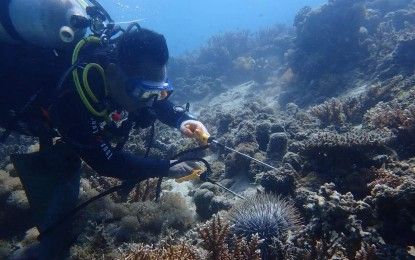Crown of thorns strikes again.
While others are battling illegal fishers and poachers, Southern Leyte is yet again plagued by the starfish species that is slowly killing its reefs.
Locally known as dap-ag, the crown of thorns (COTS) kind has been raising concerns as it started to create an infestation in the Panaon Island, a declared protected area since 2023.
Since 2019 during the first discovery of COTS in the area, the Department of Environment and Natural Resources (DENR)-Region 8 (Eastern Visayas) and other government and non-government organizations stepped up to lend a hand.
Locals have also volunteered to help protect the island from these "invaders".
Daunting Task
Despite their limited resources, 12 regular members of what is known as “dap-ag boys” spend weekends with the daunting task of collecting the invasive sea stars.
Ryan Tomol, one of the founders of the group, said the group is composed of fishermen and government workers who had been diving for COTs since 2019.
The dap-ag boys, Tomol said, have already taken out around 6,000 COTs within a 100-meter underwater area from the shoreline. They estimated a collection of 200 to 300 COTS per dive on weekends. Each dive lasts 60 to 75 minutes.
“Our concern for the livelihood of fishermen has been driving us to collect starfish. Without healthy reefs, fish will be gone,” he said. Tomol works as an administrative staff at the Southern Leyte State University.
Effective Method
The dap-ag boys remove COTS from coral reefs and bury them.
This is the best way to eliminate the destructive starfish!
“Collecting and burying COTS is the most effective method of eradicating the coral predator. We tried to inject the starfish with bile salt or vinegar, but buoyancy underwater affects the process,” Tomol added.
Chopping the starfish in half or into smaller pieces is discouraged since they can regenerate arms and, in extreme cases, may be able to regenerate from only half of an animal.
In 2016, volunteer divers in Siquijor were injecting vinegar or vinegar based solutions to the base of an arm (at least 20 ml), the COT will die between 24 and 48 hours later and will slowly start dissolving and thereby providing easy food for interested fish and invertebrates.
Natural Phenomenon?
However, to this day, scientists still do not exactly agree why COT outbreaks occur and have been hypothesized as a natural phenomenon.
Fluctuations in temperature, salinity, and nutrient levels have been documented as possible contributors to outbreaks.
Regardless of the cause, the only way to end the infestation is through a collective effort from locals, volunteers and the government agencies.
For now, there appears to be no short cuts or long term solutions to protect Panaon, from nature’s course.
#WeTakeAStand #OpinYon #OpinYonStories #DENR
